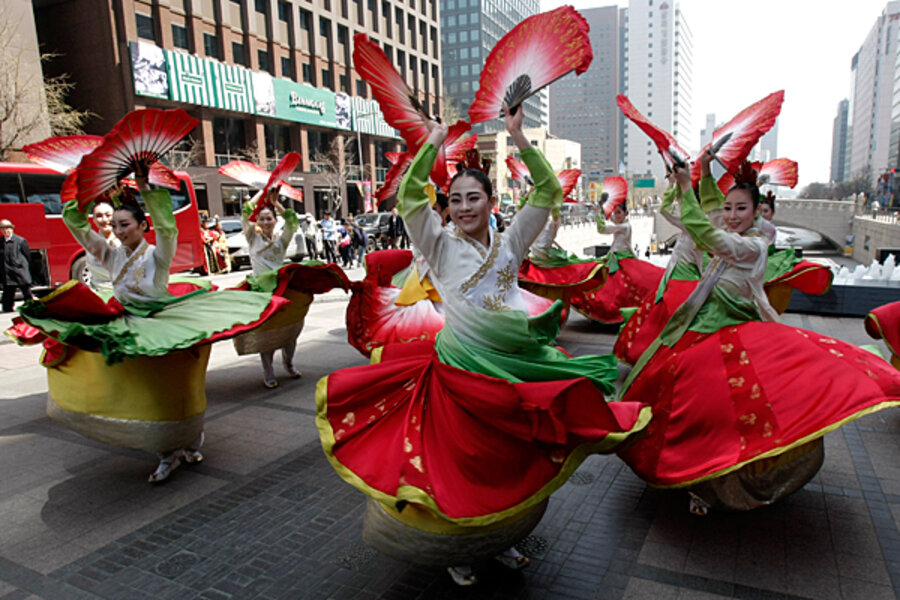South Korea retools its 'brand' in drive for more tourists
Loading...
| Jeju Island, South Korea
Not surprisingly, most of the people who make the steep 600-ft. climb up the side of the volcanic excrescence here known as “Sunrise Peak” do so to watch the sun rise over the ocean.
But when I reached the top and looked back over my shoulder at this small island off the coast of South Korea, the view was equally extraordinary. Wherever I looked, there was a volcano. Actually, wherever I looked there were several volcanoes.
The local government, though, is keen to promote Jeju’s other charms, from its lava caves to its beaches to its seafood, as it spearheads South Korea’s campaign to transform itself into a major tourist destination.
“Visit Korea” is a two-year, government-sponsored promotion currently under way to push another side of the country that many perceive as an emerging industrial behemoth still technically at war with its unpredictable neighbor to the north.
Not necessarily what you might be looking for in a vacation destination.
Polishing South Korea's brand image
“Korea’s brand image is not that spectacular,” admits Chung Un-an, a former prime minister. Mr. Chung is leading Jeju Island’s quest to become one of the “New Seven Wonders of Nature” in an international opinion poll in November, organized by a Swiss foundation.
Locals are optimistic; their island, they point out, is the only place in the world with UNESCO-designated biosphere reserves, world geo parks, and world natural heritage sites.
If Jeju wins, says Chung, “Korea might escape its industrial image. People would understand that we have tried to maintain the beauty of nature.” There is nothing South Korea can do to escape its geography, or its hermit neighbor which lobbed artillery shells across the border last November, killing four people.
That attack “caused huge damage to Korea’s tourism industry,” says Lee Jae-kyong, vice-president of marketing for the Korea Tourism Organization. “Our industry is affected by surrounding factors we cannot control.”
Happily for Mr. Lee, however, tourist memories seem to be short. In the past, he says, North Korean attacks have depressed visitor numbers for only a month or two, and overall numbers have been rising every year for the past three years.
A whopping 8.8 million tourists came to South Korea last year, up 12.5 percent from 2009 but still only enough to make the country the 10th most popular tourist destination in Asia. Much of the growth was driven by regional powerhouse China, which was Korea’s second-largest tourist market last year, behind Japan.
Some 1.3 million Chinese visited Korea in 2010, up 40 percent from 2009.
The lure of Korean pop music, sea slug, and volcanoes
While the Korean authorities are marketing their country in America and Europe as a gateway to Asia (“we tell them please start your visit to Asia in Korea,” Lee says) they don’t have to be so coy elsewhere.
In China, for example, where Korean pop music and soap operas are all the rage, “Korea is a quality, must-see destination only two hours away,” boasts Lee.
“Our Chinese market is growing really fast,” he adds. “In [the] future it will be No. 1.”
Jeju is especially popular with Chinese visitors, and while the vast majority of them come for the reasons Gov. Woo Keun-min wants, he acknowledges that last year about 1,000 Chinese took advantage of the island’s tourist-friendly “no visa” policy but then melt into the countryside as illegal, job-seeking immigrants.
“We are stepping up security to deal with the problem,” he says.
The vast majority of visitors, though, many of them arriving on direct flights from Beijing, Shanghai, and three other Chinese cities, tour the scenery (tangerine groves at the foot of snowy-peaked Mount Halla make for a startling juxtaposition), taste the sashimi (raw seaslug, anyone? It is surprisingly crunchy), and do all the things tourists do.
Nowhere else are quite so many volcanoes crammed into one place as on Jeju – the island 45 miles long by 20 miles wide boasts no fewer than 368 of the distinctive bowl-cratered cones in a range of sizes.
One of them is particularly accessible – the crater of the Geomun volcano, where air vents rising from the earth’s core create miniscule micro-climates. When I visited in early February, that meant small patches of green moss standing out in the snow-covered forest. Different trees of the same species standing just a few feet apart will blossom at completely different times, depending on their proximity to one of these vents.
Kim Sang-soo, my guide and the mayor of Sunheul 2-ri, a village at the foot of Geomun, insists that the air in the crater is full of positive ions that energize visitors. There was certainly a spring in my step that I would not have expected as I descended from the two-hour walk through snow.
To protect the volcano’s environment, the local authorities allow only 300 visitors a day, so Sunheul 2-ri’s residents probably would not benefit much from any surge in tourism that might follow Jeju’s coronation as a New Seven Wonder of Nature.
Elsewhere on the island, though, anticipation levels are high. “There will be more foreigners here if we win,” says Hong Hee-ok, proprietor of the “Pumpkin” restaurant in the restored ancient village of Seongup as she tastes the pork and seaweed soup she is serving for breakfast. “That means more business.”
The Korean phone company is offering a special cheap rate for people calling the Swiss phone number at which they can register as many votes as they like for Jeju. “I call six times a day,” Mrs. Hong laughs.





